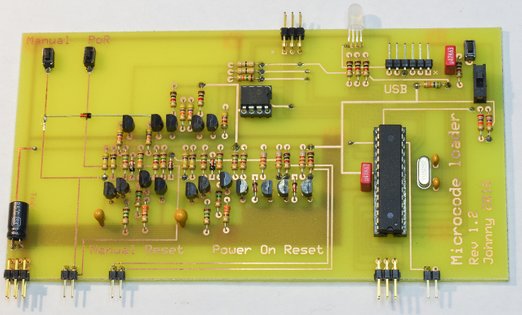Johnny's home-built CPU corner (and other stuff, maybe)
8080 CPU, built entirely by DTL-technology
Microcode Loader
The Microcode Loader has only one function: To load microcode into the SRAM at power up. That is done by an ATmega328. Once the job is done it goes to sleep and stays there.
The same board is also housing the RESET circuit and the Power On Reset circuit. It was logical to place all this together.
The plan is to have the ATmega328 talk over RS232 (USB) with my PC for downloading the microcode. That way I figure it will be simpler to make changes in the microcode and download it again instead of "burning" it into the controllers FLASH memory.
The downloaded microcode will then be stored in a 64 KB EEPROM (empty 8-pin socket).
At power up the controller will read the EEPROM and download the microcode into the SRAM.
Why I'm I using SRAM instead of ROM ?? The short answer is : Speed!
I'm using SRAM with 15 nS access time (at the cost of a lot of power).
The fastest, locally available, ROM/FLASH I can lay my hands on has around 70 nS access time. Thats to slow for me.
And besides, if I have to change anything in the microcode then... Well...
SRAM makes everything so easy.
Should anyone be interested to see whats going on, click the image to the left.
Large picture, 1600x1621 pixels
Homebuilt CPUs WebRing
Join the ring?
To join the Homebuilt CPUs ring, drop Warren a line, mentioning your page's URL. He'll then add it to the list.
You will need to copy this code fragment into your page (or reference it.)
Note: The ring is chartered for projects that include a home-built CPU. It can emulate a commercial part, that′s OK.
But actually using that commercial CPU doesn′t rate. Likewise, the project must have been at least partially built: pure paper designs don′t rate either.
It can be built using any technology you like, from relays to FPGAs.

